2009 PORSCHE CAYMAN light
[x] Cancel search: lightPage 33 of 284
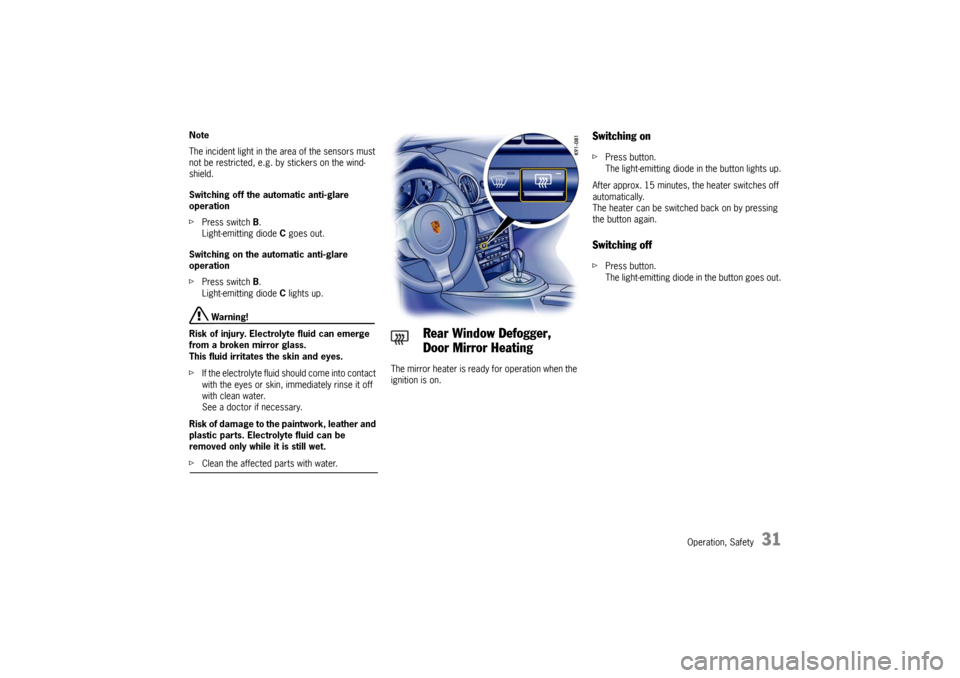
Operation, Safety
31
Note
The incident light in the area of the sensors must
not be restricted, e.g. by stickers on the wind-
shield.
Switching off the automatic anti-glare
operation
fPress switch B.
Light-emitting diode C goes out.
Switching on the automatic anti-glare
operation
f Press switch B.
Light-emitting diode C lights up.
Warning!
Risk of injury. Electrolyte fluid can emerge
from a broken mirror glass.
This fluid irritates the skin and eyes.
f If the electrolyte fluid should come into contact
with the eyes or skin, immediately rinse it off
with clean water.
See a doctor if necessary.
Risk of damage to the paintwork, leather and
plastic parts. Electrolyte fluid can be
removed only while it is still wet.
f Clean the affected parts with water. The mirror heater is ready for operation when the
ignition is on.
Switching on f
Press button.
The light-emitting diode in the button lights up.
After approx. 15 minutes, the heater switches off
automatically.
The heater can be switched back on by pressing
the button again.Switching off f Press button.
The light-emitting diode in the button goes out.
Rear Window Defogger,
Door Mirror Heating
Page 34 of 284
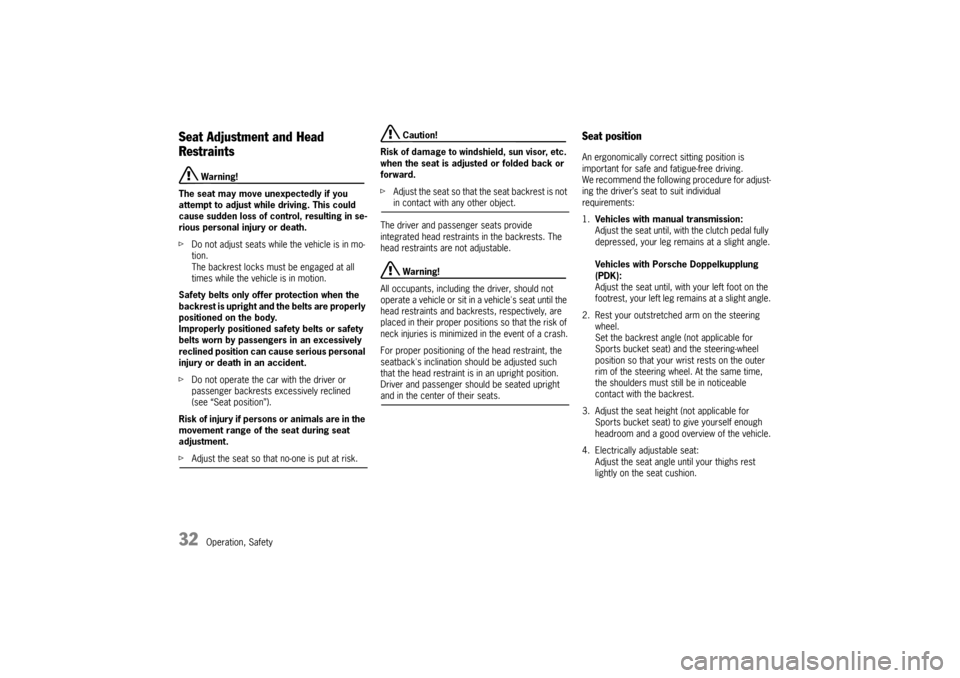
32
Operation, Safety
Seat Adjustment and Head
Restraints
Warning!
The seat may move unexpectedly if you
attempt to adjust while driving. This could
cause sudden loss of control, resulting in se-
rious personal injury or death.
f Do not adjust seats while the vehicle is in mo-
tion.
The backrest locks must be engaged at all
times while the vehicle is in motion.
Safety belts only offer protection when the
backrest is upright and the belts are properly
positioned on the body.
Improperly positioned sa fety belts or safety
belts worn by passengers in an excessively
reclined position can cause serious personal
injury or death in an accident.
f Do not operate the car with the driver or
passenger backrests excessively reclined
(see “Seat position”).
Risk of injury if persons or animals are in the
movement range of the seat during seat
adjustment.
f Adjust the seat so that no-one is put at risk.
Caution!
Risk of damage to windshield, sun visor, etc.
when the seat is adjusted or folded back or
forward.
f Adjust the seat so that the s e a t b a c k re s t i s n o t in contact with any other object.
The driver and passenger seats provide
integrated head restraints in the backrests. The
head restraints are not adjustable. Warning!
All occupants, including the driver, should not
operate a vehicle or sit in a vehicle's seat until the
head restraints and backrests, respectively, are
placed in their proper posi tions so that the risk of
neck injuries is minimize d in the event of a crash.
For proper positioning of the head restraint, the
seatback's inclination should be adjusted such
that the head restraint is in an upright position.
Driver and passenger should be seated upright
and in the center of their seats.
Seat positionAn ergonomically correct sitting position is
important for safe and fatigue-free driving.
We recommend the following procedure for adjust-
ing the driver’s seat to suit individual
requirements:
1. Vehicles with manual transmission:
Adjust the seat until, with the clutch pedal fully
depressed, your leg remains at a slight angle.
Vehicles with Porsche Doppelkupplung
(PDK):
Adjust the seat until, with your left foot on the
footrest, your left leg remains at a slight angle.
2. Rest your outstretched arm on the steering wheel.
Set the backrest angle (not applicable for
Sports bucket seat) and the steering-wheel
position so that your wr ist rests on the outer
rim of the steering wheel. At the same time,
the shoulders must still be in noticeable
contact with the backrest.
3. Adjust the seat height (not applicable for
Sports bucket seat) to give yourself enough
headroom and a good overview of the vehicle.
4. Electrically adjustable seat: Adjust the seat angle until your thighs rest
lightly on the seat cushion.
Page 39 of 284
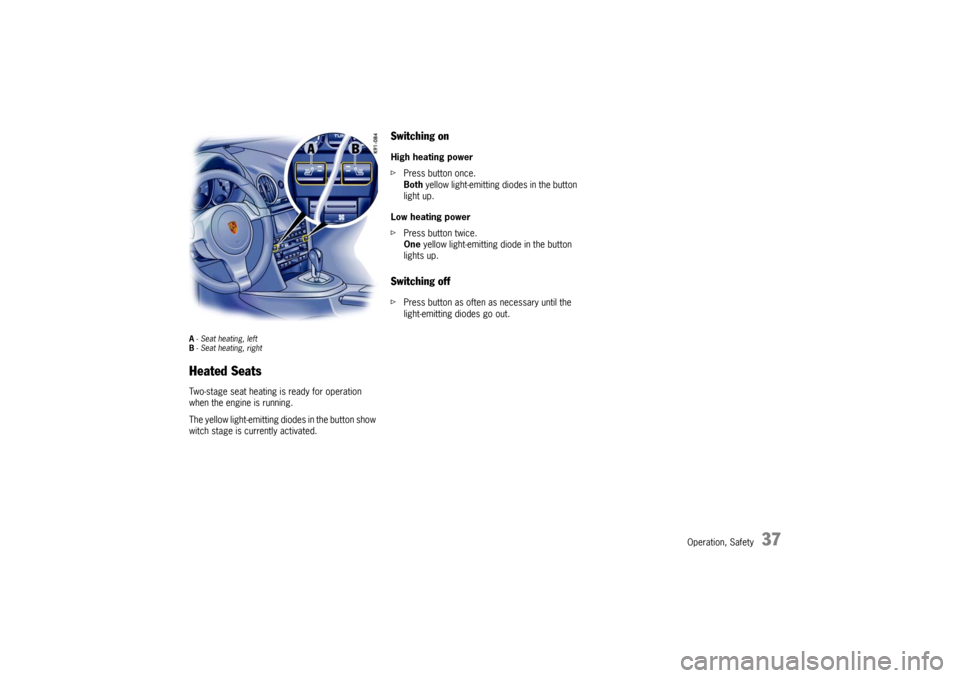
Operation, Safety
37
A- Seat heating, left
B -Seat heating, rightHeated SeatsTwo-stage seat heating is ready for operation
when the engine is running.
The yellow light-emitting diodes in the button show
witch stage is currently activated.
Switching onHigh heating power
f Press button once.
Both yellow light-emitting diodes in the button
light up.
Low heating power
f Press button twice.
One yellow light-emitting diode in the button
lights up.Switching offf Press button as often as necessary until the
light-emitting diodes go out.
Page 40 of 284
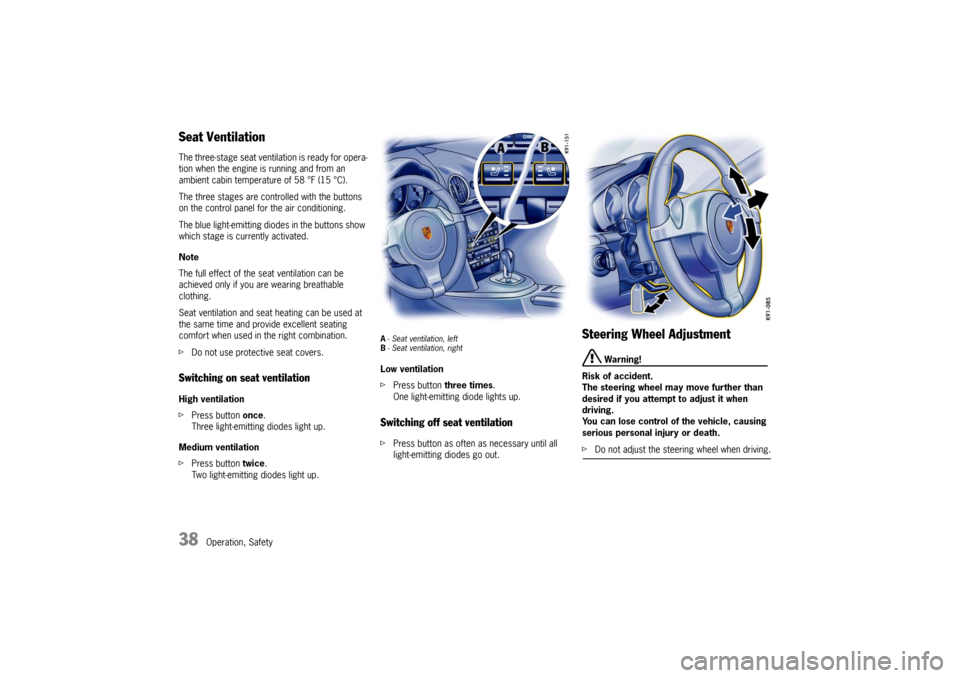
38
Operation, Safety
Seat VentilationThe three-stage seat ventilation is ready for opera-
tion when the engine is running and from an
ambient cabin temperature of 58 °F (15 °C).
The three stages are controlled with the buttons
on the control panel for the air conditioning.
The blue light-emitting diodes in the buttons show
which stage is currently activated.
Note
The full effect of the seat ventilation can be
achieved only if you are wearing breathable
clothing.
Seat ventilation and seat heating can be used at
the same time and provide excellent seating
comfort when used in the right combination.
f Do not use protective seat covers.Switching on seat ventilationHigh ventilation
fPress button once.
Three light-emitting diodes light up.
Medium ventilation
f Press button twice.
Two light-emitting diodes light up.
A - Seat ventilation, left
B - Seat ventilation, rightLow ventilation
f Press button three times.
One light-emitting diode lights up.Switching off seat ventilationf Press button as often as necessary until all
light-emitting diodes go out.
Steering Wheel Adjustment
Warning!
Risk of accident.
The steering wheel may move further than
desired if you attempt to adjust it when
driving.
You can lose control of the vehicle, causing
serious personal injury or death.
f Do not adjust the steeri ng wheel when driving.
Page 41 of 284
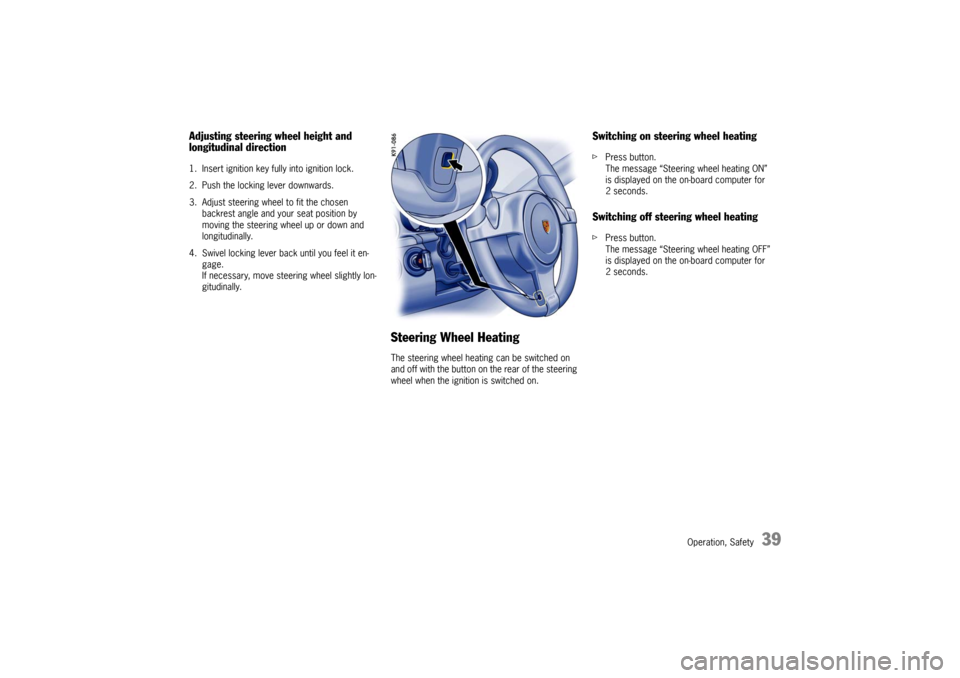
Operation, Safety
39
Adjusting steering wheel height and
longitudinal direction1. Insert ignition key fully into ignition lock.
2. Push the locking lever downwards.
3. Adjust steering wheel to fit the chosen backrest angle and your seat position by
moving the steering wheel up or down and
longitudinally.
4. Swivel locking lever back until you feel it en- gage.
If necessary, move steering wheel slightly lon-
gitudinally.
Steering Wheel HeatingThe steering wheel heatin g can be switched on
and off with the button on the rear of the steering
wheel when the ignition is switched on.
Switching on steering wheel heatingf Press button.
The message “Steering wheel heating ON”
is displayed on the on-board computer for
2seconds.Switching off steering wheel heatingfPress button.
The message “Steering wheel heating OFF”
is displayed on the on-board computer for
2seconds.
Page 44 of 284

42
Operation, Safety
Safety Belts
Warning!
Always make sure your and your passenger’s
safety belts are properly fastened while the
vehicle is in motion.
Failure to follow safety belt warnings may re-
sult in serious personal injury or death.
f For your and your passenger’s protection, use
safety belts at all times while the vehicle is in
motion.
f Use appropriate child restraint systems for all
small children.
Proper wearing of safety belts
f S a f e t y b e l t s m u s t b e p o s i t i o n e d o n t h e b o d y a s
to restrain the upper body and lap from sliding
forward. Improperly positioned safety belts
can cause serious personal injury or death in
case of an accident.
f The shoulder belt should always rest on your
upper body. The shoulder belt should never be
worn behind your back or under your arm.
f For maximum effectiveness, the lap belt
should be worn low across the hips.
f Pregnant women should position the belt as
low as possible across the pelvis. Make sure it
is not pressing against the abdomen. f
Belts should not be worn twisted.
f Do not wear belts over rigid or breakable ob-
jects in or on your clothing, such as eye glass-
es, pens, keys, etc. as these may cause injury.
f Several layers of heavy clothing may interfere
with proper positioning of belts.
f Belts must not rub against sharp objects or
damage may occur to the belt.
f Two occupants should never share the same
belt at the same time.
Care and maintenance
f Keep belt buckles free of any obstruction that
may prevent a secure locking.
f Belts that have been subjected to excessive
stretch forces in an accident must be inspect-
ed or replaced to ensure their continued effec-
tiveness in restraining you.
The same applies to belt tensioner systems
which have been triggered.
In addition, the anchor points of the belts
should be checked.
f If safety belts do not work properly, see your
authorized Porsche dealer immediately.
f I f t h e b e l t s s h o w d a m a g e t o w e b b i n g , b i n d i n g s ,
buckles or retractors, they should be replaced
to ensure safe operation.
f Do not modify or disasse mble the safety belts
in your vehicle. f
The belts must be kept clean or the retractors
may not work properly.
Please see the chapter “CAR CARE INSTRUC-
TIONS” on Page 203.
f Never bleach or dye safety belts.
f Do not allow safety belts to retract until they
are completely dry after cleaning or this may
cause damage to the belt.
Belt tensioner Depending on the force of an impact, fastened
safety belts are tightened in an accident.
The belt tensioners are triggered in:
– Front, side and rear impacts of sufficient
severity.
Note
The belt-tensioner system can be triggered only
once; the system must be replaced afterward.
If there is a fault in the belt-tensioner system, the
airbag warning light lights up.
Work may be performed on the belt-tensioner sys-
tem only by an authorized Porsche dealer.
Smoke is released when the belt tensioners are
triggered. This does not indicate a fire in the
vehicle.
Page 45 of 284
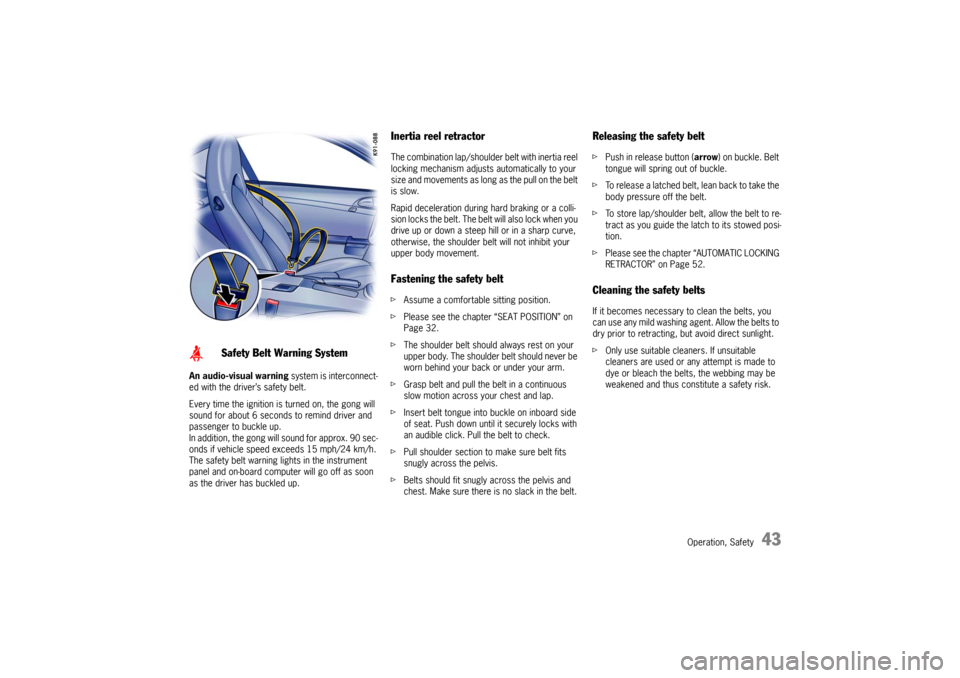
Operation, Safety
43
An audio-visual warning system is interconnect-
ed with the driver ’s safety belt.
Every time the ignition is turned on, the gong will
sound for about 6 seconds to remind driver and
passenger to buckle up.
In addition, the gong will sound for approx. 90 sec-
onds if vehicle speed exceeds 15 mph/24 km/h.
The safety belt warning lights in the instrument
panel and on-board computer will go off as soon
as the driver has buckled up.
Inertia reel retractor The combination lap/shoulder belt with inertia reel
locking mechanism adjusts automatically to your
size and movements as long as the pull on the belt
is slow.
Rapid deceleration during hard braking or a colli-
sion locks the belt. The belt will also lock when you
drive up or down a steep hill or in a sharp curve,
otherwise, the shoulder belt will not inhibit your
upper body movement.Fastening the safety beltf Assume a comfortable sitting position.
f Please see the chapter “SEAT POSITION” on
Page 32.
f The shoulder belt should always rest on your
upper body. The shoulder belt should never be
worn behind your back or under your arm.
f Grasp belt and pull the belt in a continuous
slow motion across your chest and lap.
f Insert belt tongue into buckle on inboard side
of seat. Push down until it securely locks with
an audible click. Pull the belt to check.
f Pull shoulder section to make sure belt fits
snugly across the pelvis.
f Belts should fit snugly across the pelvis and
chest. Make sure there is no slack in the belt.
Releasing the safety beltf Push in release button (arrow ) on buckle. Belt
tongue will spring out of buckle.
f To release a latched belt, lean back to take the
body pressure off the belt.
f To store lap/shoulder belt, allow the belt to re-
tract as you guide the latch to its stowed posi-
tion.
f Please see the chapter “AUTOMATIC LOCKING
RETRACTOR” on Page 52.Cleaning the safety beltsIf it becomes necessary to clean the belts, you
can use any mild washing agent. Allow the belts to
dry prior to retracting, but avoid direct sunlight.
f Only use suitable cleaners. If unsuitable
cleaners are used or any attempt is made to
dye or bleach the belt s, the webbing may be
weakened and thus constitute a safety risk.
Safety Belt Warning System
Page 46 of 284

44
Operation, Safety
Airbag SystemsThe airbags in combination with the safety belts
make up a safety system which offers the driver
and the passenger the greatest known protection
from injuries in case of accident.
Your vehicle is equipped with a weight sensing sys-
tem for the passenger's seat in accordance with
U.S. Federal Motor Vehicl e Safety Standard 208.
Even if your vehicle is equipped with airbags, the
safety belts must be worn at all times ,
because the front airbag system is only deployed
by frontal collisions with an impact of sufficient
severity.
Below the deployment threshold of the airbag sys-
tem, and during types of collisions which do not
cause the actuation of the system, the safety belts
provide the primary protection to the occupants
when correctly worn.
Therefore, all persons within the vehicle
must wear safety belts at all times (in many
states, state law requires the use of safety belts).
f Please see the chapter “SAFETY BELTS” on
Page 42.
The front airbags are located under the padded
steering wheel panel on the driver’s side and, on
the passenger's side, in the dashboard.
The side airbags are installed on the side in the
seat backrests.
The head airbags are installed in the door linings.
Danger!
To provide optimal occupant protection, air-
bags must inflate at very high speed. If you
are not wearing your safety belt or are too
close to the airbag when it is deployed, infla-
ting airbags can result in serious personal in-
jury or death.
f Make sure there are no people, animals or ob-
jects between the driver or passenger and the
area into which the airbag inflates.
f Sit back as far from the dashboard or steering
wheel as is practical, while still maintaining full
vehicle control.
f Always hold the steering wheel by the outer
rim. Never rest your hands on the airbag panel.
f Always fasten seat belts because triggering
of the airbag system depends on the force and
angle of impact.
f Do not transport heavy objects on or in front of
the passenger’s seat. These could impair the
function of the airbag , the seat belts, and
weight sensing.
f Do not hang objects (e.g . jackets, coats, coat
hangers) over the backrest. f
Always keep the lid of the door storage com-
partment closed. Objects must not protrude
out of the door storage compartment.
f No changes may be made to the wiring or
components of the airbag system.
f Do not add any additional coverings or stickers
to the steering wheel or in the area of the pas-
senger airbag, side airbags and head airbags.
Doing so may adversely affect the functioning
of the airbag system or cause harm to the oc-
cupants if the airbag system should deploy.
Do not use protective seat covers.
f Do not modify the seat coverings. Do not at-
tach additional cushions, protective coverings,
or pillows to the passenger's seat. Do not affix
things to the passenger's seat or cover it with
other materials. Do not cover the back of the
backrest. Do not make changes to the passen-
ger's seat and to the seat base frame.
f Do not undertake any wiri ng for electrical ac-
cessory equipment in the vicinity of the airbag
wiring harnesses. Doing so may disable the air-
bag system or cause inadvertent inflation.
f If the warning light co mes on, the airbag sys-
tem should be repaired immediately by your
authorized Porsche dealer.
f Always keep feet in the footwell while driving.
Do not put feet on the dashboard or the seat
area. Do not lean against the inside of the door
or outside the window while the vehicle is mov-
ing.